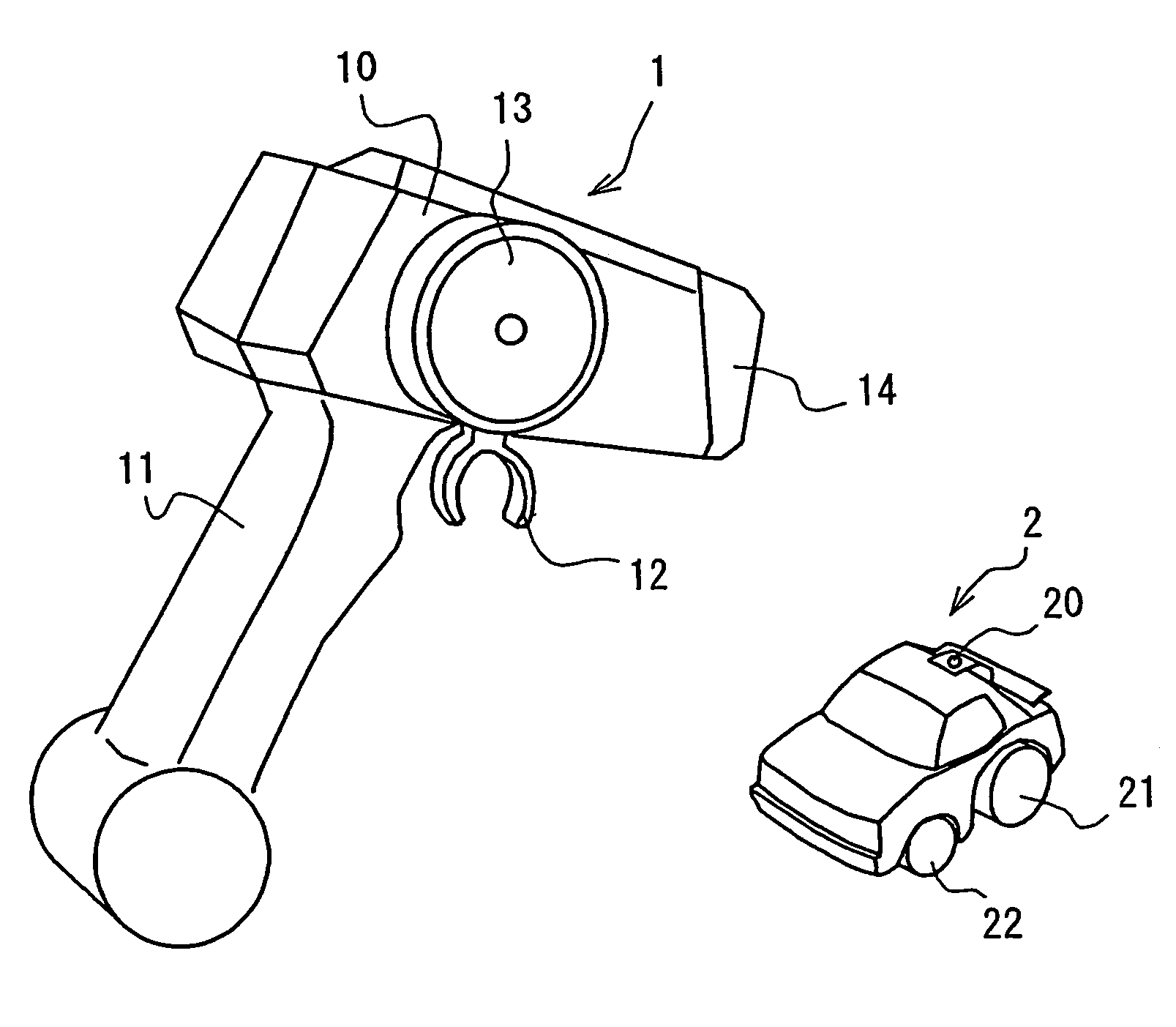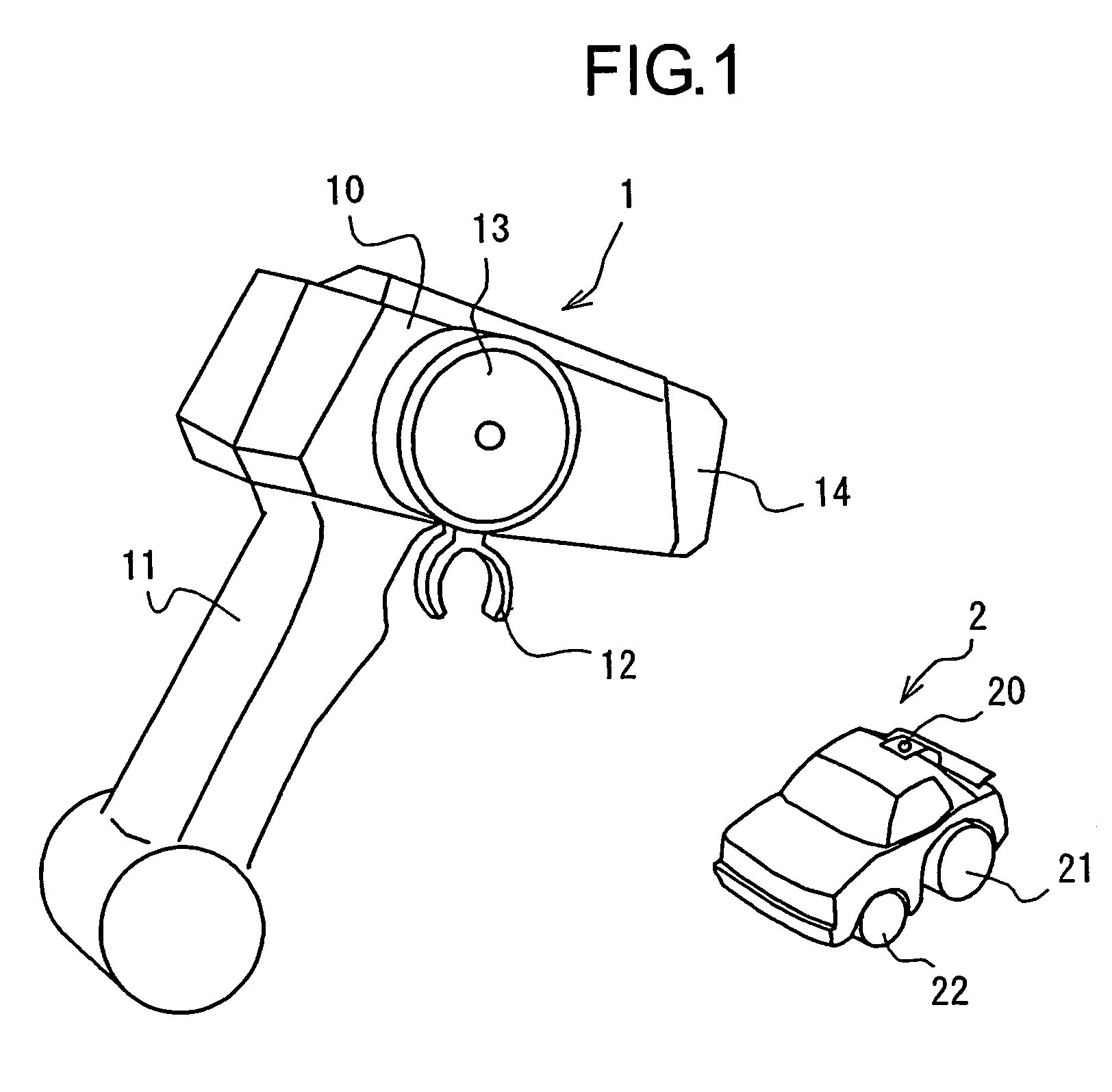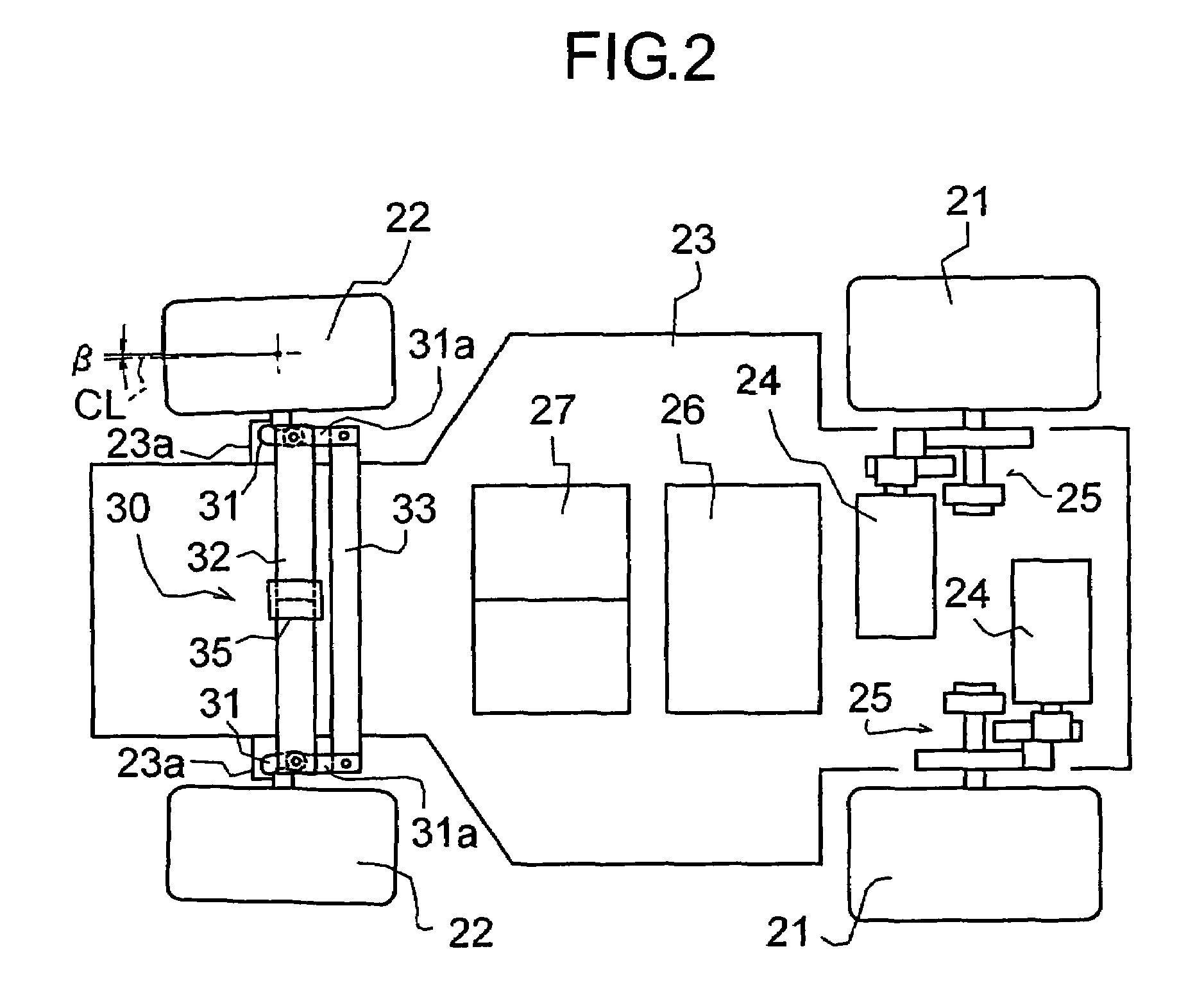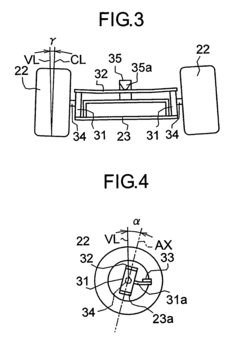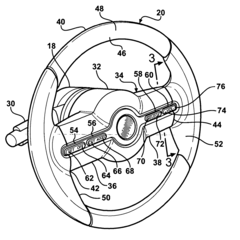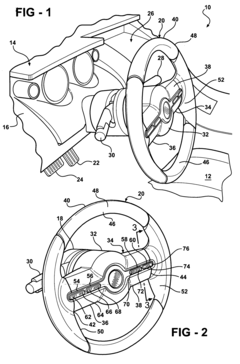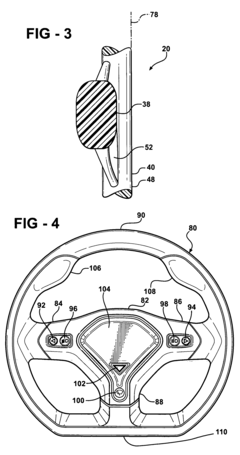Steering Wheel Trends: Influence on Automotive Industry Growth
JUL 18, 20259 MIN READ
Generate Your Research Report Instantly with AI Agent
Patsnap Eureka helps you evaluate technical feasibility & market potential.
Steering Wheel Evolution
The steering wheel has undergone significant evolution since its inception in the automotive industry. Initially, steering wheels were simple circular devices designed solely for directional control. As vehicles became more complex and driver expectations increased, steering wheels evolved to incorporate additional functionalities and ergonomic considerations.
In the early 20th century, steering wheels were typically large in diameter to provide leverage for manual steering systems. They were often made of wood or bakelite, with minimal consideration for comfort or aesthetics. As power steering became more prevalent in the 1950s and 1960s, steering wheel designs began to change. The diameter decreased, and materials shifted towards plastics and metals, improving durability and reducing weight.
The 1970s and 1980s saw the introduction of padded steering wheels, enhancing driver comfort and safety. This period also marked the beginning of integrating additional controls into the steering wheel, such as horn buttons and cruise control switches. The advent of airbags in the late 1980s and early 1990s further transformed steering wheel design, necessitating a central hub to house the airbag mechanism.
As automotive technology advanced, steering wheels became increasingly sophisticated. The late 1990s and early 2000s witnessed the integration of audio controls, allowing drivers to adjust volume and change tracks without removing their hands from the wheel. This trend continued with the addition of buttons for phone controls, voice commands, and various vehicle settings.
The 21st century has seen a rapid acceleration in steering wheel technology. Multi-function steering wheels have become standard in many vehicles, featuring controls for infotainment systems, driver assistance features, and even customizable displays. The introduction of paddle shifters on performance and luxury vehicles has further expanded the steering wheel's role in vehicle control.
Recent years have brought about significant innovations in steering wheel design. Heated steering wheels for comfort in cold climates, capacitive touch controls for a sleeker appearance, and even shape-shifting steering wheels that can change form for different driving modes have emerged. The integration of LED displays within the steering wheel rim provides real-time information to drivers, enhancing the human-machine interface.
Looking towards the future, the steering wheel's evolution is closely tied to advancements in autonomous driving technology. Concepts for retractable steering wheels that can disappear during autonomous operation are being explored, potentially redefining the driver's interaction with the vehicle. Additionally, biometric sensors integrated into steering wheels are being developed to monitor driver health and alertness, further enhancing safety features.
In the early 20th century, steering wheels were typically large in diameter to provide leverage for manual steering systems. They were often made of wood or bakelite, with minimal consideration for comfort or aesthetics. As power steering became more prevalent in the 1950s and 1960s, steering wheel designs began to change. The diameter decreased, and materials shifted towards plastics and metals, improving durability and reducing weight.
The 1970s and 1980s saw the introduction of padded steering wheels, enhancing driver comfort and safety. This period also marked the beginning of integrating additional controls into the steering wheel, such as horn buttons and cruise control switches. The advent of airbags in the late 1980s and early 1990s further transformed steering wheel design, necessitating a central hub to house the airbag mechanism.
As automotive technology advanced, steering wheels became increasingly sophisticated. The late 1990s and early 2000s witnessed the integration of audio controls, allowing drivers to adjust volume and change tracks without removing their hands from the wheel. This trend continued with the addition of buttons for phone controls, voice commands, and various vehicle settings.
The 21st century has seen a rapid acceleration in steering wheel technology. Multi-function steering wheels have become standard in many vehicles, featuring controls for infotainment systems, driver assistance features, and even customizable displays. The introduction of paddle shifters on performance and luxury vehicles has further expanded the steering wheel's role in vehicle control.
Recent years have brought about significant innovations in steering wheel design. Heated steering wheels for comfort in cold climates, capacitive touch controls for a sleeker appearance, and even shape-shifting steering wheels that can change form for different driving modes have emerged. The integration of LED displays within the steering wheel rim provides real-time information to drivers, enhancing the human-machine interface.
Looking towards the future, the steering wheel's evolution is closely tied to advancements in autonomous driving technology. Concepts for retractable steering wheels that can disappear during autonomous operation are being explored, potentially redefining the driver's interaction with the vehicle. Additionally, biometric sensors integrated into steering wheels are being developed to monitor driver health and alertness, further enhancing safety features.
Automotive Market Analysis
The automotive industry has experienced significant growth and transformation in recent years, driven by technological advancements, changing consumer preferences, and evolving regulatory landscapes. The global automotive market size reached $2.8 trillion in 2021, with projections indicating continued expansion at a compound annual growth rate (CAGR) of 4.5% through 2030. This growth is largely attributed to increasing vehicle production, rising disposable incomes, and growing urbanization in emerging economies.
The passenger vehicle segment dominates the market, accounting for over 70% of total vehicle sales worldwide. However, the commercial vehicle sector is witnessing faster growth due to the booming e-commerce industry and the need for efficient logistics solutions. Electric vehicles (EVs) have emerged as a disruptive force, with global EV sales surpassing 6.6 million units in 2021, representing a 108% increase from the previous year.
Regional analysis reveals that Asia-Pacific leads the automotive market, with China being the largest producer and consumer of vehicles. Europe and North America follow closely, with these regions focusing on premium and luxury vehicle segments. Emerging markets in Latin America, Africa, and Southeast Asia are expected to drive future growth, as rising middle-class populations fuel demand for personal mobility solutions.
The automotive industry is undergoing a paradigm shift towards connected, autonomous, shared, and electric (CASE) vehicles. This transition is reshaping market dynamics and creating new opportunities for both established players and new entrants. The global market for autonomous vehicles is projected to reach $556.67 billion by 2026, growing at a CAGR of 39.47% from 2021 to 2026.
Steering wheel trends play a crucial role in this evolving landscape. The integration of advanced driver assistance systems (ADAS) and autonomous driving technologies is transforming steering wheels from simple control devices to sophisticated human-machine interfaces. The global automotive steering system market is expected to grow from $26.3 billion in 2020 to $34.8 billion by 2025, at a CAGR of 5.8%.
Consumer preferences are shifting towards more technologically advanced and customizable steering wheels. Features such as touch-sensitive controls, haptic feedback, and biometric sensors are becoming increasingly common. These innovations not only enhance driver comfort and safety but also contribute to the overall growth of the automotive industry by driving demand for premium vehicles and aftermarket upgrades.
The passenger vehicle segment dominates the market, accounting for over 70% of total vehicle sales worldwide. However, the commercial vehicle sector is witnessing faster growth due to the booming e-commerce industry and the need for efficient logistics solutions. Electric vehicles (EVs) have emerged as a disruptive force, with global EV sales surpassing 6.6 million units in 2021, representing a 108% increase from the previous year.
Regional analysis reveals that Asia-Pacific leads the automotive market, with China being the largest producer and consumer of vehicles. Europe and North America follow closely, with these regions focusing on premium and luxury vehicle segments. Emerging markets in Latin America, Africa, and Southeast Asia are expected to drive future growth, as rising middle-class populations fuel demand for personal mobility solutions.
The automotive industry is undergoing a paradigm shift towards connected, autonomous, shared, and electric (CASE) vehicles. This transition is reshaping market dynamics and creating new opportunities for both established players and new entrants. The global market for autonomous vehicles is projected to reach $556.67 billion by 2026, growing at a CAGR of 39.47% from 2021 to 2026.
Steering wheel trends play a crucial role in this evolving landscape. The integration of advanced driver assistance systems (ADAS) and autonomous driving technologies is transforming steering wheels from simple control devices to sophisticated human-machine interfaces. The global automotive steering system market is expected to grow from $26.3 billion in 2020 to $34.8 billion by 2025, at a CAGR of 5.8%.
Consumer preferences are shifting towards more technologically advanced and customizable steering wheels. Features such as touch-sensitive controls, haptic feedback, and biometric sensors are becoming increasingly common. These innovations not only enhance driver comfort and safety but also contribute to the overall growth of the automotive industry by driving demand for premium vehicles and aftermarket upgrades.
Technical Challenges
The automotive industry is currently facing significant technical challenges in steering wheel design and implementation, driven by the rapid evolution of vehicle technology and changing consumer expectations. One of the primary challenges is the integration of advanced driver assistance systems (ADAS) and autonomous driving features into steering wheel interfaces. As vehicles become more automated, steering wheels must evolve to accommodate new functionalities while maintaining intuitive control for drivers.
Another major challenge is the development of adaptive steering systems that can seamlessly transition between manual and autonomous driving modes. This requires sophisticated sensor technology and control algorithms to ensure smooth handovers and maintain safety. Additionally, the industry is grappling with the need to reduce steering wheel size and weight without compromising structural integrity or safety standards, particularly in electric vehicles where space and weight optimization are crucial.
The incorporation of haptic feedback and touch-sensitive controls into steering wheels presents another technical hurdle. Engineers must balance the need for advanced features with the importance of maintaining a distraction-free driving experience. This involves developing robust, reliable touch interfaces that can withstand the harsh automotive environment and provide clear, tactile feedback to drivers.
Sustainability and material innovation also pose significant challenges in steering wheel design. The industry is under pressure to develop eco-friendly materials that meet stringent safety and durability requirements while reducing environmental impact. This includes exploring alternatives to traditional leather and plastic components, as well as implementing recycling and circular economy principles in manufacturing processes.
Furthermore, the increasing demand for personalization and customization in vehicle interiors is pushing the boundaries of steering wheel design. Manufacturers are challenged to create modular and adaptable steering wheel systems that can be easily customized to meet individual preferences without compromising safety or functionality. This requires innovative manufacturing techniques and materials that allow for flexibility in design and production.
Lastly, the integration of biometric sensors and health monitoring capabilities into steering wheels presents both opportunities and challenges. While these features can enhance driver safety and comfort, they also raise complex issues related to data privacy, sensor reliability, and regulatory compliance. Engineers must navigate these concerns while developing steering wheels that can accurately monitor driver health and alertness without being intrusive or distracting.
Another major challenge is the development of adaptive steering systems that can seamlessly transition between manual and autonomous driving modes. This requires sophisticated sensor technology and control algorithms to ensure smooth handovers and maintain safety. Additionally, the industry is grappling with the need to reduce steering wheel size and weight without compromising structural integrity or safety standards, particularly in electric vehicles where space and weight optimization are crucial.
The incorporation of haptic feedback and touch-sensitive controls into steering wheels presents another technical hurdle. Engineers must balance the need for advanced features with the importance of maintaining a distraction-free driving experience. This involves developing robust, reliable touch interfaces that can withstand the harsh automotive environment and provide clear, tactile feedback to drivers.
Sustainability and material innovation also pose significant challenges in steering wheel design. The industry is under pressure to develop eco-friendly materials that meet stringent safety and durability requirements while reducing environmental impact. This includes exploring alternatives to traditional leather and plastic components, as well as implementing recycling and circular economy principles in manufacturing processes.
Furthermore, the increasing demand for personalization and customization in vehicle interiors is pushing the boundaries of steering wheel design. Manufacturers are challenged to create modular and adaptable steering wheel systems that can be easily customized to meet individual preferences without compromising safety or functionality. This requires innovative manufacturing techniques and materials that allow for flexibility in design and production.
Lastly, the integration of biometric sensors and health monitoring capabilities into steering wheels presents both opportunities and challenges. While these features can enhance driver safety and comfort, they also raise complex issues related to data privacy, sensor reliability, and regulatory compliance. Engineers must navigate these concerns while developing steering wheels that can accurately monitor driver health and alertness without being intrusive or distracting.
Current Steering Solutions
01 Advanced steering control systems
Modern steering wheels are incorporating advanced control systems, including electronic power steering, steer-by-wire technology, and adaptive steering. These systems enhance vehicle handling, improve fuel efficiency, and provide a more customizable driving experience. They also enable features like lane-keeping assist and autonomous driving capabilities.- Advanced steering control systems: Modern steering wheels are incorporating advanced control systems, including electronic power steering, adaptive steering, and steer-by-wire technologies. These systems enhance vehicle handling, improve fuel efficiency, and provide a more customizable driving experience. They also enable features like lane-keeping assist and autonomous driving capabilities.
- Integration of multi-function controls: Steering wheels are increasingly equipped with integrated controls for various vehicle functions. These include audio system controls, cruise control, phone connectivity, and voice command interfaces. This trend aims to improve driver convenience and reduce distractions by keeping essential controls within easy reach.
- Ergonomic design and materials: There is a growing focus on ergonomic steering wheel designs that enhance comfort and reduce driver fatigue. This includes the use of new materials such as soft-touch plastics, leather wraps, and heated steering wheels. Adjustable steering columns and shape-adaptive steering wheels are also becoming more common to accommodate different driving positions and preferences.
- Safety enhancements: Steering wheel designs are evolving to improve safety features. This includes the integration of advanced airbag systems, impact-absorbing materials, and collapsible steering columns. Some designs also incorporate sensors to detect driver grip and alertness, contributing to overall vehicle safety systems.
- Innovative shapes and retractable designs: As autonomous driving technology advances, steering wheel designs are becoming more innovative. This includes concepts for retractable or foldaway steering wheels that can be stowed when not in use, as well as non-traditional shapes that optimize space and functionality in future vehicle interiors. Some designs also explore the use of drive-by-wire systems that could potentially replace traditional mechanical steering linkages.
02 Multifunctional steering wheels
Steering wheels are evolving to become multifunctional control centers. They now often include integrated controls for audio systems, cruise control, phone connectivity, and vehicle information displays. This trend aims to reduce driver distraction by placing essential controls within easy reach.Expand Specific Solutions03 Ergonomic and customizable designs
There is a growing focus on ergonomic steering wheel designs that enhance comfort and reduce driver fatigue. This includes adjustable steering columns, heated steering wheels, and customizable grip materials. Some designs also allow for personalized settings that can be saved and recalled for different drivers.Expand Specific Solutions04 Integration of safety features
Steering wheels are increasingly incorporating advanced safety features. This includes airbag systems integrated into the steering wheel, haptic feedback for driver alerts, and sensors to detect driver grip and attentiveness. These features work in conjunction with other vehicle safety systems to enhance overall occupant protection.Expand Specific Solutions05 Sustainable and lightweight materials
There is a trend towards using sustainable and lightweight materials in steering wheel construction. This includes the use of recycled materials, bio-based polymers, and advanced composites. The goal is to reduce vehicle weight for improved fuel efficiency while maintaining durability and performance.Expand Specific Solutions
Industry Leaders
The steering wheel market is in a mature stage of development, with a significant global market size driven by the automotive industry's growth. The technology is well-established, but continuous innovations are being made to enhance safety, connectivity, and user experience. Major players like Autoliv, Honda, BYD, and Geely are investing heavily in R&D to maintain their competitive edge. Established automakers such as BMW, Audi, and Mercedes-Benz are focusing on integrating advanced features into steering wheels, while newer entrants like Tesla are exploring alternative control systems. The market is characterized by intense competition and a focus on technological advancements to meet evolving consumer demands and regulatory requirements.
Ford Global Technologies LLC
Technical Solution: Ford has been pioneering innovative steering wheel technologies to enhance driver experience and safety. They have developed a retractable steering wheel system for autonomous vehicles, which can seamlessly transition between manual and autonomous driving modes[1]. This system includes sensors to detect driver readiness and can provide haptic feedback. Ford is also exploring steer-by-wire technology, which replaces mechanical linkages with electronic controls, allowing for more flexible steering wheel designs and improved vehicle packaging[2]. Additionally, they are integrating advanced driver-assistance features directly into the steering wheel, such as lane-keeping aids and adaptive cruise control interfaces[3].
Strengths: Adaptability for autonomous driving, enhanced safety features, and improved ergonomics. Weaknesses: Potential complexity and higher costs, reliance on electronic systems that may be vulnerable to failures.
AUDI AG
Technical Solution: Audi has been developing steering wheel technologies that focus on enhancing both performance and comfort. They have introduced a flat-bottom steering wheel design in many models, improving ergonomics and sportiness[10]. Audi's latest steering wheels incorporate touch-sensitive controls and haptic feedback, allowing drivers to operate various functions without taking their hands off the wheel[11]. The company is also exploring the use of organic LED displays integrated into the steering wheel rim to provide customizable information and controls. Furthermore, Audi is developing advanced steer-by-wire systems that can adjust steering feel and feedback based on driving modes and conditions, enhancing both comfort and performance[12].
Strengths: Sporty ergonomics, advanced haptic feedback, and customizable interfaces. Weaknesses: Potential for driver distraction with complex controls, higher production costs, and possible reliability issues with advanced electronic systems.
Key Steering Innovations
Automobile model
PatentInactiveUS7553212B2
Innovation
- The implementation of a steered wheel-supporting mechanism that allows left and right steered wheels to turn in association with each other, with an inclined steering axis and positive caster angle, enabling natural steering by reaction forces from the ground and stabilizing the turning attitude through resiliency.
Automotive steering wheel
PatentInactiveUS20060162485A1
Innovation
- A steering wheel assembly with a contoured web for hand support, collinear spokes, integrated control switches for cruise control, audio device management, and safety features like air bags, enhancing ergonomic grip and convenience by distributing controls on the steering wheel hub.
Regulatory Framework
The regulatory framework surrounding steering wheel design and implementation plays a crucial role in shaping the automotive industry's growth and innovation. Governments and regulatory bodies worldwide have established stringent safety standards and guidelines to ensure the protection of drivers and passengers. These regulations significantly influence the development and adoption of new steering wheel technologies.
In the United States, the National Highway Traffic Safety Administration (NHTSA) sets Federal Motor Vehicle Safety Standards (FMVSS) that dictate specific requirements for steering wheel design, including impact protection, airbag integration, and ergonomics. Similarly, the European Union enforces regulations through the United Nations Economic Commission for Europe (UNECE), which provides harmonized standards for vehicle components, including steering systems.
As autonomous driving technologies advance, regulatory bodies are adapting their frameworks to accommodate new steering wheel concepts. For instance, the NHTSA has begun to consider exemptions for vehicles without traditional steering wheels, recognizing the potential for fully autonomous vehicles. This shift in regulatory approach is opening up new possibilities for automotive design and functionality.
The regulatory landscape also addresses the integration of advanced driver assistance systems (ADAS) into steering wheels. Regulations now cover the incorporation of sensors, haptic feedback mechanisms, and control interfaces within the steering wheel structure. These requirements aim to enhance driver awareness and vehicle control while maintaining safety standards.
Environmental considerations are increasingly influencing steering wheel regulations. Sustainability mandates are pushing manufacturers to explore eco-friendly materials and production processes for steering wheel components. This trend aligns with broader automotive industry goals to reduce carbon footprints and promote circular economy principles.
Cybersecurity has emerged as a critical aspect of steering wheel regulations, particularly with the rise of connected and autonomous vehicles. Regulatory bodies are developing frameworks to ensure that steering systems are protected against potential cyber threats, safeguarding vehicle control and passenger safety.
The global nature of the automotive industry necessitates harmonization of steering wheel regulations across different regions. Efforts are underway to align standards and testing procedures, facilitating international trade and reducing compliance costs for manufacturers. This harmonization process is expected to accelerate innovation and market adoption of new steering wheel technologies.
In the United States, the National Highway Traffic Safety Administration (NHTSA) sets Federal Motor Vehicle Safety Standards (FMVSS) that dictate specific requirements for steering wheel design, including impact protection, airbag integration, and ergonomics. Similarly, the European Union enforces regulations through the United Nations Economic Commission for Europe (UNECE), which provides harmonized standards for vehicle components, including steering systems.
As autonomous driving technologies advance, regulatory bodies are adapting their frameworks to accommodate new steering wheel concepts. For instance, the NHTSA has begun to consider exemptions for vehicles without traditional steering wheels, recognizing the potential for fully autonomous vehicles. This shift in regulatory approach is opening up new possibilities for automotive design and functionality.
The regulatory landscape also addresses the integration of advanced driver assistance systems (ADAS) into steering wheels. Regulations now cover the incorporation of sensors, haptic feedback mechanisms, and control interfaces within the steering wheel structure. These requirements aim to enhance driver awareness and vehicle control while maintaining safety standards.
Environmental considerations are increasingly influencing steering wheel regulations. Sustainability mandates are pushing manufacturers to explore eco-friendly materials and production processes for steering wheel components. This trend aligns with broader automotive industry goals to reduce carbon footprints and promote circular economy principles.
Cybersecurity has emerged as a critical aspect of steering wheel regulations, particularly with the rise of connected and autonomous vehicles. Regulatory bodies are developing frameworks to ensure that steering systems are protected against potential cyber threats, safeguarding vehicle control and passenger safety.
The global nature of the automotive industry necessitates harmonization of steering wheel regulations across different regions. Efforts are underway to align standards and testing procedures, facilitating international trade and reducing compliance costs for manufacturers. This harmonization process is expected to accelerate innovation and market adoption of new steering wheel technologies.
Human-Machine Interface
The human-machine interface (HMI) in steering wheels has become a critical focal point in the automotive industry, significantly influencing vehicle design, user experience, and overall industry growth. As vehicles evolve towards greater connectivity and automation, steering wheels are transforming into sophisticated control centers, integrating a wide array of functions beyond traditional steering.
Modern steering wheels now incorporate touch-sensitive surfaces, haptic feedback systems, and voice control capabilities. These advancements allow drivers to manage infotainment systems, adjust vehicle settings, and interact with advanced driver assistance systems (ADAS) without removing their hands from the wheel. This integration enhances safety by reducing driver distraction and improving overall ergonomics.
The trend towards multifunctional steering wheels has led to the development of innovative HMI solutions. Capacitive touch sensors embedded in the steering wheel rim enable gesture controls, allowing drivers to swipe or tap to navigate menus or adjust settings. Some manufacturers have introduced small touchscreen displays directly on the steering wheel, providing customizable information and control interfaces.
Haptic feedback technology in steering wheels has also gained traction, offering tactile responses to driver inputs and alerts. This feature not only enhances the user experience but also serves as an additional safety measure by providing non-visual cues to the driver. For instance, vibrations can warn of lane departures or potential collisions, complementing visual and auditory alerts.
Voice recognition systems integrated into steering wheel controls have significantly improved, allowing for more natural and intuitive interactions. Drivers can now issue voice commands to control various vehicle functions, make phone calls, or adjust navigation settings without taking their eyes off the road. This hands-free operation aligns with the industry's focus on minimizing driver distraction and enhancing safety.
The evolution of steering wheel HMI is closely tied to the advancement of autonomous driving technologies. As vehicles progress through different levels of autonomy, steering wheels are being designed to seamlessly transition between manual and autonomous modes. Some concept vehicles have showcased retractable steering wheels that can be stowed away during fully autonomous operation, fundamentally altering the cabin layout and user experience.
These HMI innovations in steering wheels are driving growth in the automotive industry by creating new opportunities for differentiation and value addition. Suppliers specializing in HMI technologies are experiencing increased demand, while automakers are investing heavily in research and development to create unique and compelling user interfaces. The focus on steering wheel HMI is also spurring collaborations between automotive companies and technology firms, fostering innovation and cross-industry partnerships.
Modern steering wheels now incorporate touch-sensitive surfaces, haptic feedback systems, and voice control capabilities. These advancements allow drivers to manage infotainment systems, adjust vehicle settings, and interact with advanced driver assistance systems (ADAS) without removing their hands from the wheel. This integration enhances safety by reducing driver distraction and improving overall ergonomics.
The trend towards multifunctional steering wheels has led to the development of innovative HMI solutions. Capacitive touch sensors embedded in the steering wheel rim enable gesture controls, allowing drivers to swipe or tap to navigate menus or adjust settings. Some manufacturers have introduced small touchscreen displays directly on the steering wheel, providing customizable information and control interfaces.
Haptic feedback technology in steering wheels has also gained traction, offering tactile responses to driver inputs and alerts. This feature not only enhances the user experience but also serves as an additional safety measure by providing non-visual cues to the driver. For instance, vibrations can warn of lane departures or potential collisions, complementing visual and auditory alerts.
Voice recognition systems integrated into steering wheel controls have significantly improved, allowing for more natural and intuitive interactions. Drivers can now issue voice commands to control various vehicle functions, make phone calls, or adjust navigation settings without taking their eyes off the road. This hands-free operation aligns with the industry's focus on minimizing driver distraction and enhancing safety.
The evolution of steering wheel HMI is closely tied to the advancement of autonomous driving technologies. As vehicles progress through different levels of autonomy, steering wheels are being designed to seamlessly transition between manual and autonomous modes. Some concept vehicles have showcased retractable steering wheels that can be stowed away during fully autonomous operation, fundamentally altering the cabin layout and user experience.
These HMI innovations in steering wheels are driving growth in the automotive industry by creating new opportunities for differentiation and value addition. Suppliers specializing in HMI technologies are experiencing increased demand, while automakers are investing heavily in research and development to create unique and compelling user interfaces. The focus on steering wheel HMI is also spurring collaborations between automotive companies and technology firms, fostering innovation and cross-industry partnerships.
Unlock deeper insights with Patsnap Eureka Quick Research — get a full tech report to explore trends and direct your research. Try now!
Generate Your Research Report Instantly with AI Agent
Supercharge your innovation with Patsnap Eureka AI Agent Platform!
